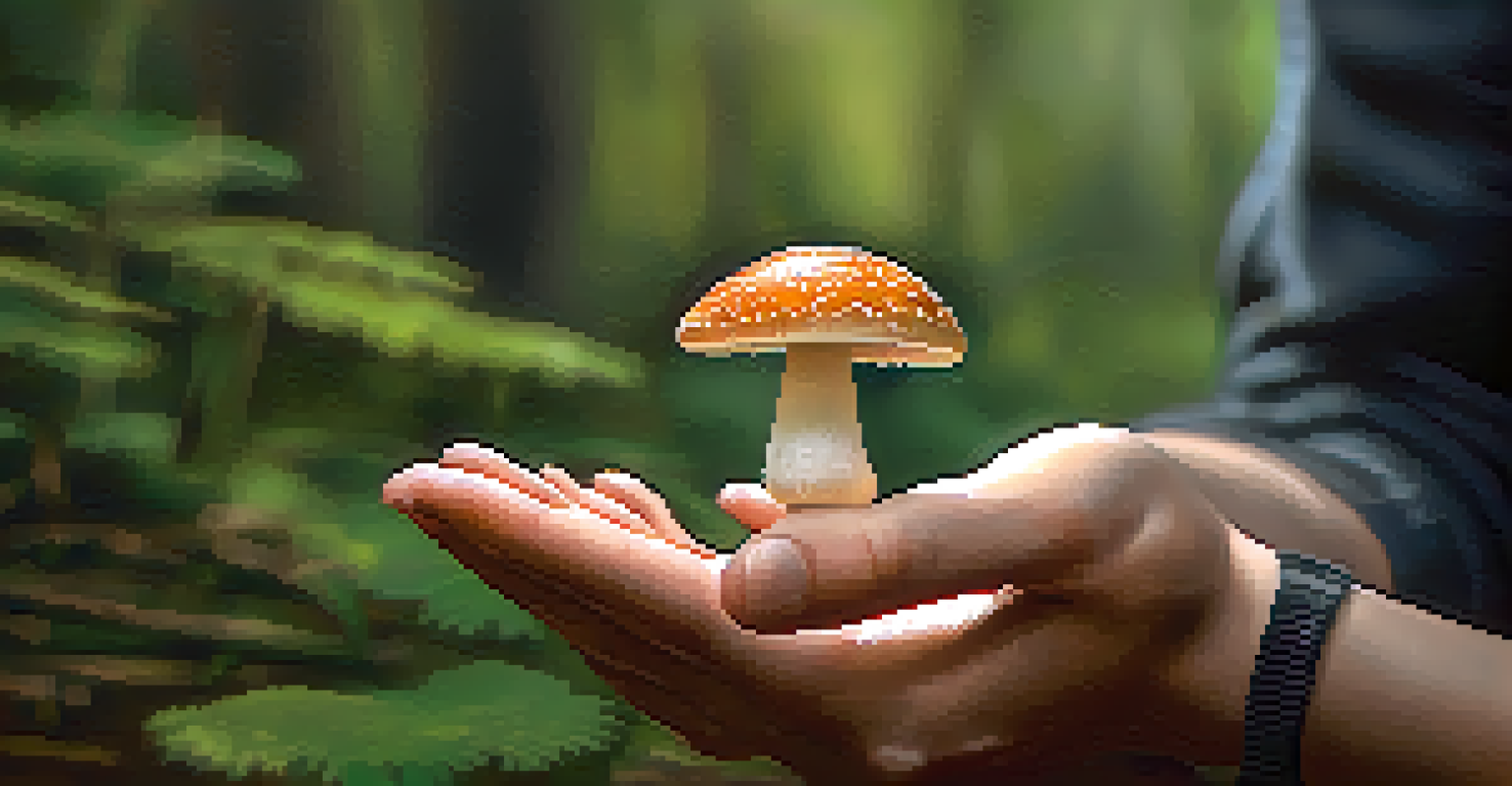Entheogens and PTSD: A Path to Healing Trauma

Understanding PTSD: A Deep Dive into the Condition
Post-Traumatic Stress Disorder (PTSD) affects millions globally, arising from traumatic experiences such as combat, accidents, or abuse. Symptoms can include flashbacks, severe anxiety, and uncontrollable thoughts about the event. This condition can severely impact daily life, making even simple tasks feel daunting.
The greatest weapon against stress is our ability to choose one thought over another.
Traditional treatments for PTSD often include therapy and medications, but many individuals find these approaches insufficient. The search for alternative therapies has led to a growing interest in entheogens—substances that can alter consciousness and potentially facilitate healing. Understanding PTSD is the first step toward exploring these new avenues for recovery.
As research progresses, the connection between PTSD and alternative treatments continues to grow. By examining the underlying mechanisms of PTSD, we can better appreciate how entheogens might offer a different approach to healing. This exploration opens doors to innovative therapies that could help those suffering from this debilitating condition.
What Are Entheogens and Their Historical Context?
Entheogens are substances like psilocybin (found in magic mushrooms) and ayahuasca that have been used for centuries in various cultural rituals. These naturally occurring compounds are known for their ability to induce altered states of consciousness, which can lead to profound spiritual experiences. Historically, they have served as tools for healing, self-discovery, and connection to the divine.

In the modern context, entheogens are being researched for their potential therapeutic benefits, particularly for mental health conditions like PTSD. By tapping into ancient practices, contemporary researchers aim to bridge the gap between tradition and modern science. This revival of interest highlights a broader understanding of mental health that extends beyond conventional methods.
Entheogens Show Promise for PTSD
Research indicates that entheogens may offer alternative therapeutic benefits for individuals suffering from PTSD.
As society becomes more open to alternative healing practices, the conversation around entheogens is evolving. People are beginning to recognize these substances not merely as recreational drugs but as powerful tools for healing. This shift in perception is crucial for exploring their potential benefits for those struggling with PTSD.
The Science Behind Entheogens and Trauma Healing
Research indicates that entheogens may impact neuroplasticity, the brain's ability to reorganize and form new connections. This can be particularly beneficial for PTSD patients, whose brains may be stuck in a trauma response. By encouraging new pathways, these substances could help individuals process traumatic memories in healthier ways.
Healing is not linear; it’s a journey, and every experience is a step toward understanding and wholeness.
Studies have shown that psychedelics can lead to experiences of interconnectedness and profound insight, which can shift one’s perspective on trauma. This new understanding can foster emotional healing and reduce the grip of traumatic memories. The idea is that by confronting trauma in a supportive setting, individuals can gain clarity and release pent-up emotions.
While more research is needed to fully understand the mechanisms at play, preliminary findings are promising. They suggest that entheogens could complement traditional therapies or even serve as standalone treatments. As researchers continue to delve into these substances, we may uncover more about their role in trauma healing.
Clinical Trials: Evidence of Efficacy in PTSD Treatment
Recent clinical trials have begun to showcase the potential of entheogens in treating PTSD. For instance, studies involving MDMA-assisted therapy have yielded significant improvements in symptoms among participants. These trials often involve guided sessions where trained therapists support individuals through their experiences, maximizing the benefits.
Participants in these studies frequently report profound emotional breakthroughs, allowing them to confront and process their trauma in a safe environment. The combination of therapy and entheogens seems to create a unique opportunity for healing. As a result, many researchers advocate for further exploration into these methods.
Personal Stories Highlight Healing
Transformative personal experiences with entheogens illustrate their potential to facilitate emotional breakthroughs and healing.
The results from these trials are encouraging, but they also highlight the importance of conducting thorough research. Each study adds valuable data to the conversation about entheogens, helping to build a case for their acceptance in mainstream treatments. As we gather more evidence, the possibilities for PTSD recovery expand.
Personal Stories: Healing Journeys with Entheogens
Many individuals have reported transformative experiences after using entheogens as part of their healing journey. For example, a veteran shared how a guided ayahuasca ceremony helped him confront his combat-related trauma. His experience allowed him to process emotions he had bottled up for years, leading to a newfound sense of peace.
These personal stories often highlight the profound impact that entheogens can have on one's psyche. Participants frequently describe feelings of connectedness to themselves and others, as well as insights that help them reframe their trauma. Such narratives underscore the importance of support systems and safe environments for these experiences to be truly beneficial.
While each story is unique, the common thread is a shared sense of healing and hope. These testimonials serve as powerful reminders of the human capacity for resilience. They also encourage others to consider alternative paths to recovery, emphasizing that healing is possible.
Challenges and Considerations in Using Entheogens
Despite the potential benefits, using entheogens for PTSD treatment is not without its challenges. One major concern is the legal status of many of these substances, which can hinder research and access for those in need. Additionally, the need for trained professionals to guide these experiences is crucial to ensure safety and efficacy.
Another consideration is the variability in individual responses to entheogens. While some may find relief, others might experience difficult emotions or anxiety during their journey. It’s essential to approach these substances with caution and respect, ensuring that individuals are adequately prepared and supported.
Challenges in Entheogen Use
Legal and individual variability challenges must be addressed to ensure safe and effective use of entheogens in PTSD treatment.
Navigating these challenges requires open dialogue and collaboration among researchers, therapists, and lawmakers. As we work toward understanding the full potential of entheogens in healing, it’s vital to create frameworks that prioritize safety, accessibility, and informed consent. This balanced approach can pave the way for innovative treatments while protecting the well-being of individuals.
The Future of Entheogens in PTSD Treatment
The future of entheogens in treating PTSD looks promising as research expands and societal perceptions evolve. Ongoing studies aim to further explore their therapeutic potential and refine treatment protocols. As more evidence emerges, we may see a shift in how mental health treatment is approached, integrating entheogens as viable options.
Furthermore, as conversations around mental health become more open and inclusive, alternative therapies are gaining traction. This cultural shift could lead to increased acceptance of entheogens, allowing more individuals to access these healing modalities. The potential for integration into conventional practices is an exciting prospect for those seeking relief from PTSD.

Ultimately, the journey toward healing is deeply personal, and entheogens may be part of that journey for some. By fostering understanding and support, we can create a landscape where individuals have the freedom to explore all avenues of recovery. The future holds hope for those navigating the complex terrain of trauma.